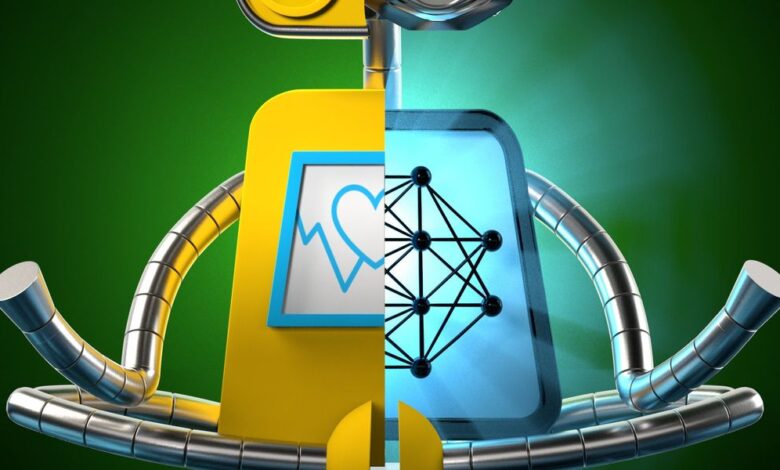Woebot, a Mental-Health Chatbot, Tries Out Generative AI

The mental-health app Woebot launched in 2017, back when “chatbot” wasn’t a familiar term and someone seeking a therapist could only imagine talking to a human being. Woebot was something exciting and new: a way for people to get on-demand mental-health support in the form of a responsive, empathic, AI-powered chatbot. Users found that the friendly robot avatar checked in on them every day, kept track of their progress, and was always available to talk something through.
Today, the situation is vastly different. Demand for mental-health services has surged while the supply of clinicians has stagnated. There are thousands of apps that offer automated support for mental health and wellness. And ChatGPT has helped millions of people experiment with conversational AI.
But even as the world has become fascinated with generative AI, people have also seen its downsides. As a company that relies on conversation, Woebot Health had to decide whether generative AI could make Woebot a better tool, or whether the technology was too dangerous to incorporate into our product.
Woebot is designed to have structured conversations through which it delivers evidence-based tools inspired by cognitive behavioral therapy (CBT), a technique that aims to change behaviors and feelings. Throughout its history, Woebot Health has used technology from a subdiscipline of AI known as natural-language processing (NLP). The company has used AI artfully and by design—Woebot uses NLP only in the service of better understanding a user’s written texts so it can respond in the most appropriate way, thus encouraging users to engage more deeply with the process.
Woebot, which is currently available in the United States, is not a generative-AI chatbot like ChatGPT. The differences are clear in both the bot’s content and structure. Everything Woebot says has been written by conversational designers trained in evidence-based approaches who collaborate with clinical experts; ChatGPT generates all sorts of unpredictable statements, some of which are untrue. Woebot relies on a rules-based engine that resembles a decision tree of possible conversational paths; ChatGPT uses statistics to determine what its next words should be, given what has come before.
With ChatGPT, conversations about mental health ended quickly and did not allow a user to engage in the psychological processes of change.
The rules-based approach has served us well, protecting Woebot’s users from the types of chaotic conversations we observed from early generative chatbots. Prior to ChatGPT, open-ended conversations with generative chatbots were unsatisfying and easily derailed. One famous example is Microsoft’s Tay, a chatbot that was meant to appeal to millennials but turned lewd and racist in less than 24 hours.
But with the advent of ChatGPT in late 2022, we had to ask ourselves: Could the new large language models (LLMs) powering chatbots like ChatGPT help our company achieve its vision? Suddenly, hundreds of millions of users were having natural-sounding conversations with ChatGPT about anything and everything, including their emotions and mental health. Could this new breed of LLMs provide a viable generative-AI alternative to the rules-based approach Woebot has always used? The AI team at Woebot Health, including the authors of this article, were asked to find out.
Woebot, a mental-health chatbot, deploys concepts from cognitive behavioral therapy to help users. This demo shows how users interact with Woebot using a combination of multiple-choice responses and free-written text.
The Origin and Design of Woebot
Woebot got its start when the clinical research psychologist Alison Darcy, with support from the AI pioneer Andrew Ng, led the build of a prototype intended as an emotional support tool for young people. Darcy and another member of the founding team, Pierre Rappolt, took inspiration from video games as they looked for ways for the tool to deliver elements of CBT. Many of their prototypes contained interactive fiction elements, which then led Darcy to the chatbot paradigm. The first version of the chatbot was studied in a randomized control trial that offered mental-health support to college students. Based on the results, Darcy raised US $8 million from New Enterprise Associates and Andrew Ng’s AI Fund.
The Woebot app is intended to be an adjunct to human support, not a replacement for it. It was built according to a set of principles that we call Woebot’s core beliefs, which were shared on the day it launched. These tenets express a strong faith in humanity and in each person’s ability to change, choose, and grow. The app does not diagnose, it does not give medical advice, and it does not force its users into conversations. Instead, the app follows a Buddhist principle that’s prevalent in CBT of “sitting with open hands”—it extends invitations that the user can choose to accept, and it encourages process over results. Woebot facilitates a user’s growth by asking the right questions at optimal moments, and by engaging in a type of interactive self-help that can happen anywhere, anytime.
These core beliefs strongly influenced both Woebot’s engineering architecture and its product-development process. Careful conversational design is crucial for ensuring that interactions conform to our principles. Test runs through a conversation are read aloud in “table reads,” and then revised to better express the core beliefs and flow more naturally. The user side of the conversation is a mix of multiple-choice responses and “free text,” or places where users can write whatever they wish.
Building an app that supports human health is a high-stakes endeavor, and we’ve taken extra care to adopt the best software-development practices. From the start, enabling content creators and clinicians to collaborate on product development required custom tools. An initial system using Google Sheets quickly became unscalable, and the engineering team replaced it with a proprietary Web-based “conversational management system” written in the JavaScript library React.
Within the system, members of the writing team can create content, play back that content in a preview mode, define routes between content modules, and find places for users to enter free text, which our AI system then parses. The result is a large rules-based tree of branching conversational routes, all organized within modules such as “social skills training” and “challenging thoughts.” These modules are translated from psychological mechanisms within CBT and other evidence-based techniques.
How Woebot Uses AI
While everything Woebot says is written by humans, NLP techniques are used to help understand the feelings and problems users are facing; then Woebot can offer the most appropriate modules from its deep bank of content. When users enter free text about their thoughts and feelings, we use NLP to parse these text inputs and route the user to the best response.
In Woebot’s early days, the engineering team used regular expressions, or “regexes,” to understand the intent behind these text inputs. Regexes are a text-processing method that relies on pattern matching within sequences of characters. Woebot’s regexes were quite complicated in some cases, and were used for everything from parsing simple yes/no responses to learning a user’s preferred nickname.
Later in Woebot’s development, the AI team replaced regexes with classifiers trained with supervised learning. The process for creating AI classifiers that comply with regulatory standards was involved—each classifier required months of effort. Typically, a team of internal-data labelers and content creators reviewed examples of user messages (with all personally identifiable information stripped out) taken from a specific point in the conversation. Once the data was placed into categories and labeled, classifiers were trained that could take new input text and place it into one of the existing categories.
This process was repeated many times, with the classifier repeatedly evaluated against a test dataset until its performance satisfied us. As a final step, the conversational-management system was updated to “call” these AI classifiers (essentially activating them) and then to route the user to the most appropriate content. For example, if a user wrote that he was feeling angry because he got in a fight with his mom, the system would classify this response as a relationship problem.
The technology behind these classifiers is constantly evolving. In the early days, the team used an open-source library for text classification called fastText, sometimes in combination with regular expressions. As AI continued to advance and new models became available, the team was able to train new models on the same labeled data for improvements in both accuracy and recall. For example, when the early transformer model BERT was released in October 2018, the team rigorously evaluated its performance against the fastText version. BERT was superior in both precision and recall for our use cases, and so the team replaced all fastText classifiers with BERT and launched the new models in January 2019. We immediately saw improvements in classification accuracy across the models.
Eddie Guy
Woebot and Large Language Models
When ChatGPT was released in November 2022, Woebot was more than 5 years old. The AI team faced the question of whether LLMs like ChatGPT could be used to meet Woebot’s design goals and enhance users’ experiences, putting them on a path to better mental health.
We were excited by the possibilities, because ChatGPT could carry on fluid and complex conversations about millions of topics, far more than we could ever include in a decision tree. However, we had also heard about troubling examples of chatbots providing responses that were decidedly not supportive, including advice on how to maintain and hide an eating disorder and guidance on methods of self-harm. In one tragic case in Belgium, a grieving widow accused a chatbot of being responsible for her husband’s suicide.
The first thing we did was try out ChatGPT ourselves, and we quickly became experts in prompt engineering. For example, we prompted ChatGPT to be supportive and played the roles of different types of users to explore the system’s strengths and shortcomings. We described how we were feeling, explained some problems we were facing, and even explicitly asked for help with depression or anxiety.
A few things stood out. First, ChatGPT quickly told us we needed to talk to someone else—a therapist or doctor. ChatGPT isn’t intended for medical use, so this default response was a sensible design decision by the chatbot’s makers. But it wasn’t very satisfying to constantly have our conversation aborted. Second, ChatGPT’s responses were often bulleted lists of encyclopedia-style answers. For example, it would list six actions that could be helpful for depression. We found that these lists of items told the user what to do but didn’t explain how to take these steps. Third, in general, the conversations ended quickly and did not allow a user to engage in the psychological processes of change.
It was clear to our team that an off-the-shelf LLM would not deliver the psychological experiences we were after. LLMs are based on reward models that value the delivery of correct answers; they aren’t given incentives to guide a user through the process of discovering those results themselves. Instead of “sitting with open hands,” the models make assumptions about what the user is saying to deliver a response with the highest assigned reward.
We had to decide whether generative AI could make Woebot a better tool, or whether the technology was too dangerous to incorporate into our product.
To see if LLMs could be used within a mental-health context, we investigated ways of expanding our proprietary conversational-management system. We looked into frameworks and open-source techniques for managing prompts and prompt chains—sequences of prompts that ask an LLM to achieve a task through multiple subtasks. In January of 2023, a platform called LangChain was gaining in popularity and offered techniques for calling multiple LLMs and managing prompt chains. However, LangChain lacked some features that we knew we needed: It didn’t provide a visual user interface like our proprietary system, and it didn’t provide a way to safeguard the interactions with the LLM. We needed a way to protect Woebot users from the common pitfalls of LLMs, including hallucinations (where the LLM says things that are plausible but untrue) and simply straying off topic.
Ultimately, we decided to expand our platform by implementing our own LLM prompt-execution engine, which gave us the ability to inject LLMs into certain parts of our existing rules-based system. The engine allows us to support concepts such as prompt chains while also providing integration with our existing conversational routing system and rules. As we developed the engine, we were fortunate to be invited into the beta programs of many new LLMs. Today, our prompt-execution engine can call more than a dozen different LLM models, including variously sized OpenAI models, Microsoft Azure versions of OpenAI models, Anthropic’s Claude, Google Bard (now Gemini), and open-source models running on the Amazon Bedrock platform, such as Meta’s Llama 2. We use this engine exclusively for exploratory research that’s been approved by an institutional review board, or IRB.
It took us about three months to develop the infrastructure and tooling support for LLMs. Our platform allows us to package features into different products and experiments, which in turn lets us maintain control over software versions and manage our research efforts while ensuring that our commercially deployed products are unaffected. We’re not using LLMs in any of our products; the LLM-enabled features can be used only in a version of Woebot for exploratory studies.
A Trial for an LLM-Augmented Woebot
We had some false starts in our development process. We first tried creating an experimental chatbot that was almost entirely powered by generative AI; that is, the chatbot directly used the text responses from the LLM. But we ran into a couple of problems. The first issue was that the LLMs were eager to demonstrate how smart and helpful they are! This eagerness was not always a strength, as it interfered with the user’s own process.
For example, the user might be doing a thought-challenging exercise, a common tool in CBT. If the user says, “I’m a bad mom,” a good next step in the exercise could be to ask if the user’s thought is an example of “labeling,” a cognitive distortion where we assign a negative label to ourselves or others. But LLMs were quick to skip ahead and demonstrate how to reframe this thought, saying something like “A kinder way to put this would be, ‘I don’t always make the best choices, but I love my child.’” CBT exercises like thought challenging are most helpful when the person does the work themselves, coming to their own conclusions and gradually changing their patterns of thinking.
A second difficulty with LLMs was in style matching. While social media is rife with examples of LLMs responding in a Shakespearean sonnet or a poem in the style of Dr. Seuss, this format flexibility didn’t extend to Woebot’s style. Woebot has a warm tone that has been refined for years by conversational designers and clinical experts. But even with careful instructions and prompts that included examples of Woebot’s tone, LLMs produced responses that didn’t “sound like Woebot,” maybe because a touch of humor was missing, or because the language wasn’t simple and clear.
The LLM-augmented Woebot was well-behaved, refusing to take inappropriate actions like diagnosing or offering medical advice.
However, LLMs truly shone on an emotional level. When coaxing someone to talk about their joys or challenges, LLMs crafted personalized responses that made people feel understood. Without generative AI, it’s impossible to respond in a novel way to every different situation, and the conversation feels predictably “robotic.”
We ultimately built an experimental chatbot that possessed a hybrid of generative AI and traditional NLP-based capabilities. In July 2023 we registered an IRB-approved clinical study to explore the potential of this LLM-Woebot hybrid, looking at satisfaction as well as exploratory outcomes like symptom changes and attitudes toward AI. We feel it’s important to study LLMs within controlled clinical studies due to their scientific rigor and safety protocols, such as adverse event monitoring. Our Build study included U.S. adults above the age of 18 who were fluent in English and who had neither a recent suicide attempt nor current suicidal ideation. The double-blind structure assigned one group of participants the LLM-augmented Woebot while a control group got the standard version; we then assessed user satisfaction after two weeks.
We built technical safeguards into the experimental Woebot to ensure that it wouldn’t say anything to users that was distressing or counter to the process. The safeguards tackled the problem on multiple levels. First, we used what engineers consider “best in class” LLMs that are less likely to produce hallucinations or offensive language. Second, our architecture included different validation steps surrounding the LLM; for example, we ensured that Woebot wouldn’t give an LLM-generated response to an off-topic statement or a mention of suicidal ideation (in that case, Woebot provided the phone number for a hotline). Finally, we wrapped users’ statements in our own careful prompts to elicit appropriate responses from the LLM, which Woebot would then convey to users. These prompts included both direct instructions such as “don’t provide medical advice” as well as examples of appropriate responses in challenging situations.
While this initial study was short—two weeks isn’t much time when it comes to psychotherapy—the results were encouraging. We found that users in the experimental and control groups expressed about equal satisfaction with Woebot, and both groups had fewer self-reported symptoms. What’s more, the LLM-augmented chatbot was well-behaved, refusing to take inappropriate actions like diagnosing or offering medical advice. It consistently responded appropriately when confronted with difficult topics like body image issues or substance use, with responses that provided empathy without endorsing maladaptive behaviors. With participant consent, we reviewed every transcript in its entirety and found no concerning LLM-generated utterances—no evidence that the LLM hallucinated or drifted off-topic in a problematic way. What’s more, users reported no device-related adverse events.
This study was just the first step in our journey to explore what’s possible for future versions of Woebot, and its results have emboldened us to continue testing LLMs in carefully controlled studies. We know from our prior research that Woebot users feel a bond with our bot. We’re excited about LLMs’ potential to add more empathy and personalization, and we think it’s possible to avoid the sometimes-scary pitfalls related to unfettered LLM chatbots.
We believe strongly that continued progress within the LLM research community will, over time, transform the way people interact with digital tools like Woebot. Our mission hasn’t changed: We’re committed to creating a world-class solution that helps people along their mental-health journeys. For anyone who wants to talk, we want the best possible version of Woebot to be there for them.
This article appears in the June 2024 print issue.
From Your Site Articles
Related Articles Around the Web



